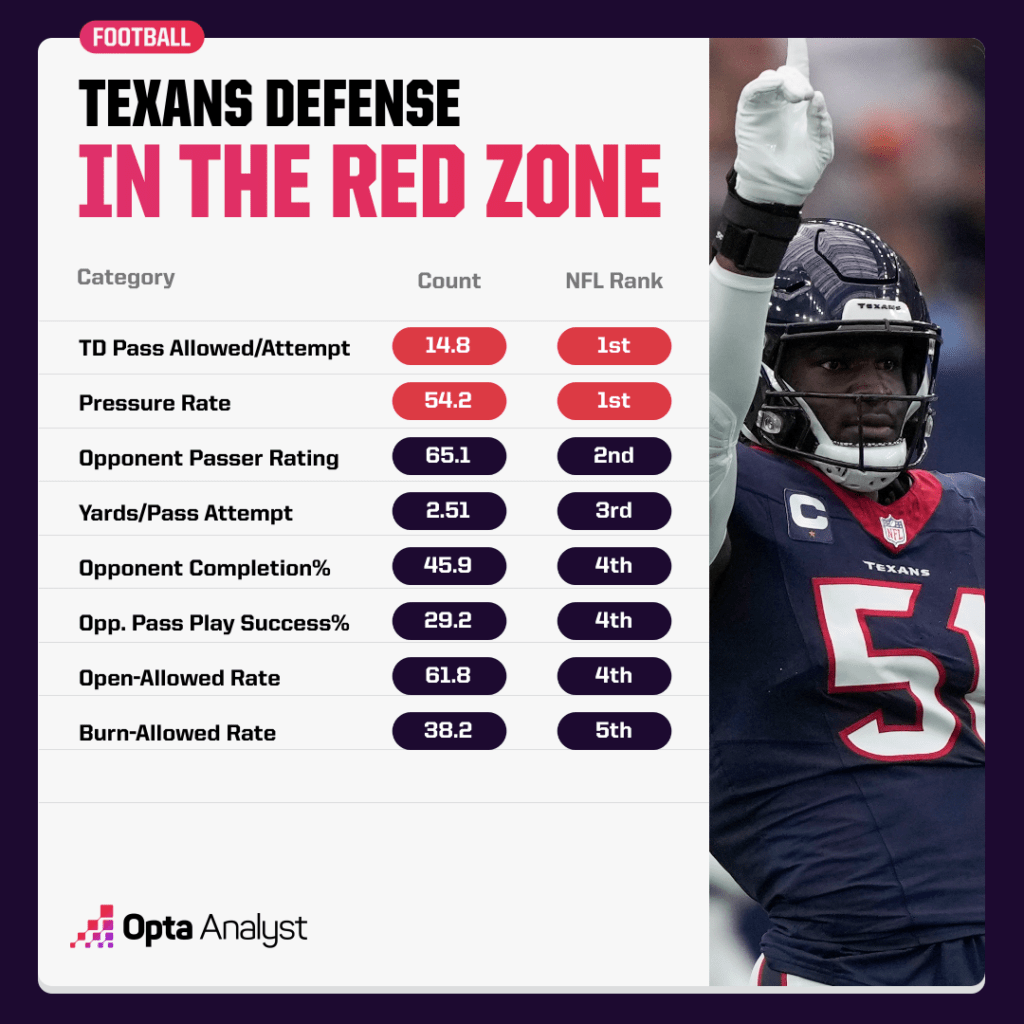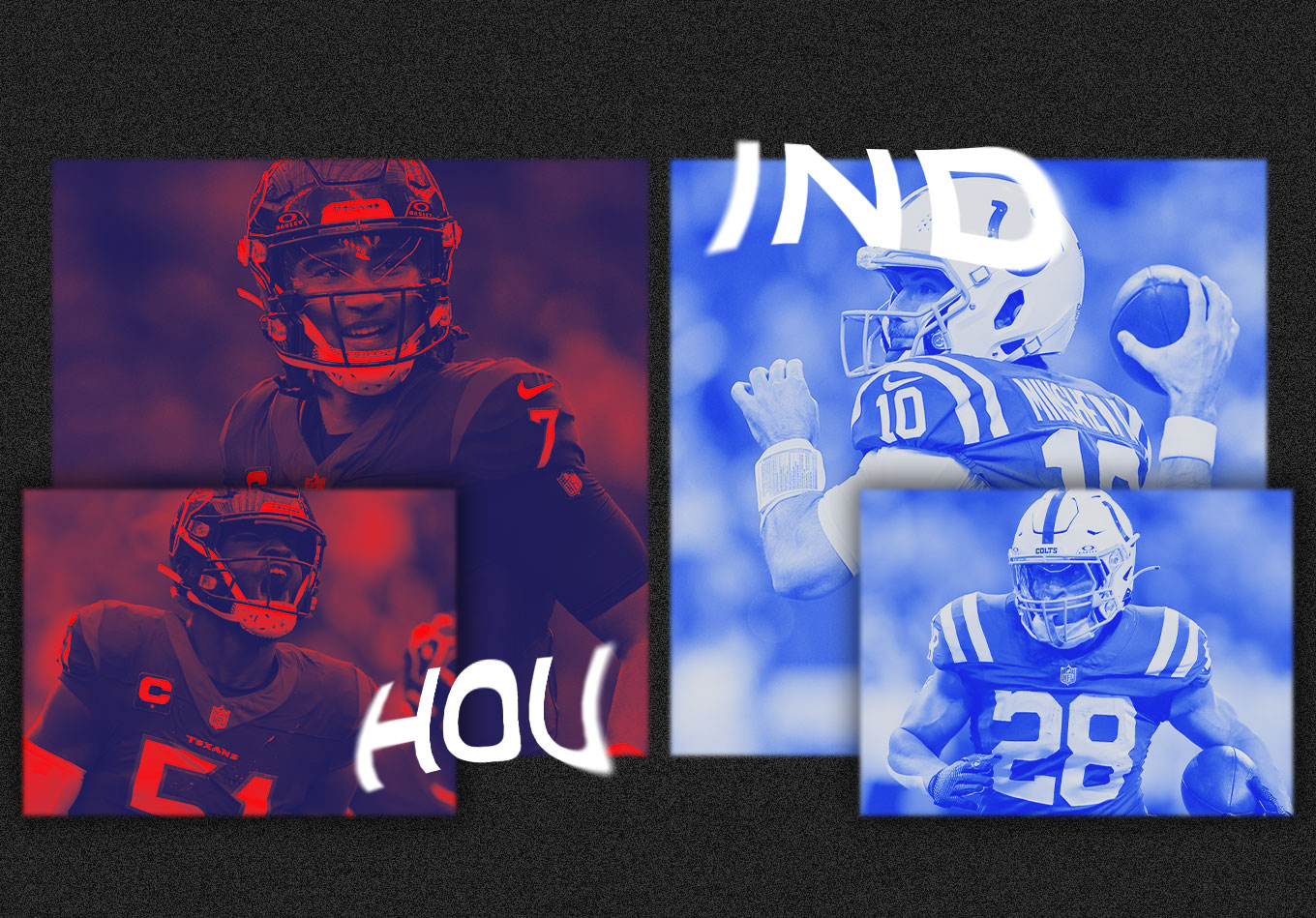What a difference a year can make.
When the Indianapolis Colts and Houston Texans met in Indiana in Week 18 of the 2022 season, both teams were wrapping up chaotic and failure-ridden seasons while in the process of determining a new path forward.
One had already fired its head coach, and the other followed suit a mere hours after Houston delivered a 32-31 win in a game that impacted nothing more than draft positioning.
Fast forward 12 months, and these same two AFC South members will get together again at Lucas Oil Stadium with a whole lot more on the line.
The winner of Saturday’s clash (on ABC/ESPN) between the NFL’s two most improved teams of 2023 is guaranteed a spot in the playoffs, while the loser will see its otherwise successful campaign come to an abrupt close.
It’s a scenario few could have envisioned after the Texans had the AFC’s worst record last season at 3-13-1 and the Colts finished just one win ahead of their division rival.
MOST IMPROVED TEAMS FROM 2022 TO 2023
- Houston Texans (+.357 win percentage increase)
- Indianapolis Colts (+.298)
- Cleveland Browns (+.276)
- Los Angeles Rams (+.269)
- Chicago Bears (+.262)
The origins of the Texans’ transformation into a postseason contender after a three-year run as the league’s laughingstock are quite evident.
They hired a culture-changing coach in DeMeco Ryans and drafted the most impactful rookie of this year’s class in C.J. Stroud, who sports the lowest interception percentage of any starting quarterback in 2023 while standing on the verge of becoming just the fifth first-year player with a 4,000-yard passing NFL season.
Indianapolis’ quick turnaround is perhaps even more impressive and something we admittedly didn’t see coming, as our supercomputer gave the Colts a 15.7% chance of making the AFC playoffs at the start of the regular season.
They’ve been outgained and outscored over the course of their 16 games and have played most of them without their own dynamic rookie quarterback after Anthony Richardson suffered a season-ending shoulder injury in NFL Week 5.
The Colts have been able to weather the storm due to veteran stand-in Gardner Minshew’s competent play and a knack for winning close games in coach Shane Steichen’s debut season, a quality the Texans have displayed as well under Ryans.
BEST RECORDS IN GAMES DECIDED BY 7 OR LESS POINTS
- Pittsburgh Steelers (8-2)
- Indianapolis Colts (6-2)
- Cleveland Browns (6-2)
- Philadelphia Eagles (7-3)
- Houston Texans (6-3)
- Miami Dolphins (4-2)
The model foresees another nip-and-tuck outcome for both combatants this week, giving Houston a razor-thin 51.5% chance to win and extend its season. The public has also tabbed the Texans as the best bets, making them current 1.0-point favorites after Indy opened as a 1.5-point choice.
PROJECTED WINNER: TEXANS
WIN PROBABILITY: 51.5%
So, let’s further break down this now-primetime monumental matchup that could even determine the AFC South champion, as the winner of this game would claim the division should the Jacksonville Jaguars continue their late-season downward spiral and lose to the Tennessee Titans on Sunday (the supercomputer gives Jacksonville a 63.5% chance to win).
Indianapolis, which came through with a 31-20 win in Houston back in Week 2, would also be crowned division champ in the event this game ends in a dreaded tie and the Titans beat the Jaguars.
HOU KEY: SLOW INDY’S PASS RUSH
The underdog Colts have vaulted into contention by winning six of their last eight games. Minshew’s improved decision-making over that stretch (which we’ll get more into later) has played a major role in the resurgence, but perhaps equally as important has been the rise to prominence of an Indianapolis pass rush that was nearly non-existent over the season’s first half.
Indianapolis had the lowest pressure rate of any team from Weeks 1-8 at 29.9%. The Colts have upped that number to 41.7% from Week 9 on, the fifth-highest rate in the NFL during that span, and they’ve registered sacks on a league-best 9.3% of opponent pass attempts over those eight games.
The Colts have done it behind a true collective effort, as they’re the only team to have four players with at least seven sacks. And most of that group consists of names likely unfamiliar to the majority of fans save for ultra-steady veteran tackle DeForest Buckner.
Buckner’s season numbers don’t jump off the screen, but the two-time Pro Bowler’s ability to draw constant double teams has created opportunities for guys like Samson Ebukam, Tyquan Lewis and Dayo Odeyingbo to consistently win 1-on-1 matchups.
Odeyingbo has 6.0 sacks in his last eight games and an adjusted sack rate of 6.6% during that stretch – fourth among edge defenders with 95 or more pass-rush attempts over that period. The versatile Lewis ranks fifth among edge players in pressure rate (23.7%) since Week 9 while being deployed both outside and along the interior.
Since the Colts blitz at the lowest rate of any team, it’s vital for them to create havoc from four-man rushes in order for coordinator Gus Bradley’s scheme to be at its most formidable.
A steady pass rush could also force the Texans to deviate from their preferred method of operation, which is to attack teams with downfield throws. Stroud’s 9.32 air yards per attempt is the second highest of any quarterback to take the majority of his team’s snaps, while his 12.86 yards per completion ranks third.
That game plan often puts the rookie sensation in stressful situations, though, and Stroud’s extended release time is a contributing factor to Houston allowing the fourth-highest rate of pressures at 42%.
LONGEST QB RELEASE TIME (MIN. 170 ADJUSTED ATTEMPTS)
- Justin Fields, Chicago Bears (3.03 seconds)
- C.J. Stroud, Houston Texans (2.90)
- Russell Wilson, Denver Nuggets (2.90)
- Joe Flacco, Cleveland Browns (2.85)
- Lamar Jackson, Baltimore Ravens (2.85)
The Colts recorded a strong 41.8% pressure rate in their Week 2 win at Houston, though that still didn’t prevent Stroud from hanging 384 yards and two touchdowns without an interception on Bradley’s unit in his first real indication that Houston now had something special at quarterback.
That performance came with the Texans having their full arsenal of receivers on hand, however, that’s a luxury they won’t have Saturday with playmaking rookie Tank Dell out for the season and Noah Brown not expected to play due to a back injury he sustained in last week’s 26-3 win over the Titans.
Dell and Brown each rank in the top 15 in burn rate among wide receivers with 50 or more targets (both over 67%). And Dell’s open rate of 84% is fifth among wideouts under those parameters.
Their absence presents some challenges for Houston play-caller Bobby Slowik, who may have to utilize Robert Woods more on the outside and away from the slot, where the veteran has been most effective. It also potentially puts the Colts in position to draw coverage towards Nico Collins, the Texans’ leading receiver who scorched Indy for 146 yards and a touchdown on seven catches back in September.
IND KEY: MINIMIZE MISTAKES/CONVERT CHANCES
Indianapolis’ second-half surge has also been fueled by an improvement in turnover differential, as it’s a plus-5 over its last eight games after posting a minus-2 margin over its 3-5 start. And Minshew has been the main reason why.
The fifth-year pro had the second-highest pickable pass percentage of any quarterback with at least 100 or more adjusted attempts from Weeks 1-8 at 6.42%. But since Week 9, Minshew has thrown just four interceptions in eight starts with a pickable pass percentage among the lowest of his contemporaries.
LOWEST PICKABLE PASS% SINCE WEEK 9 (MIN. 100 ADJUSTED ATTEMPTS)
- Derek Carr, New Orleans Saints (1.32)
- Jalen Hurts, Philadelphia Eagles (1.33)
- Gardner Minshew, Indianapolis Colts (1.59)
- Jordan Love, Green Bay Packers (2.01)
- Justin Herbert, Los Angeles Chargers (2.02)
Protecting the football is important to any offense, but it’s especially crucial for one that’s lacked explosiveness down the stretch like Indianapolis’ has. The Colts’ 19 plays of 20 or more yards since Week 9 are tied for the second fewest in the league, and only two of those plays have resulted in touchdowns.
Because they’ve been without that big-play ability, the Colts need to be a methodical, chain-moving outfit that capitalizes on its chances within the red zone – a potentially cumbersome chore against a Houston defense that often bends but doesn’t break all that much.
Ryans’ zone-based scheme hasn’t been great in defending the pass when opponents have had space to operate, as the Texans have surrendered an overall completion rate of 71% and rank 26th in open-allowed percentage (82.2) outside the red zone.
Houston’s defense stiffens significantly when backed up near its own end, however, as it ranks near the top of the league in just about every pass defense category within the red zone.

Now, the Colts do prefer to run the ball near the goal line with their capable tandem of Jonathan Taylor and Zach Moss, but the Texans are good in that area as well – and in stopping the run in general. Houston permits the fewest rushing yards per run play in both the red zone (1.9) and overall (3.1) and ranks in the top five in both overall stuff percentage (12.8) and percentage of rushing plays allowed over 10 yards (8.6).
Indianapolis did score touchdowns on all four of its red-zone trips in its Week 2 win over Houston, but two of them came on designed runs of 15 and 18 yards from the dangerous Richardson. Minshew doesn’t present anywhere near the same threat as a scrambler, and the Colts have been by and large a middle-of-the-pack team in red zone efficiency during his tenure.
The Colts will still likely lean on Taylor and the offensive line when down near the goal line, partly because they haven’t been very good throwing it there. Indianapolis’ 11 red-zone passing touchdowns are tied for 26th in the NFL, and its burn and passing play success rates inside that area also rank below league average.
Sure, the Colts do have a high-caliber, big-bodied No. 1 receiver in Michael Pittman, who has produced an exceptional 65.3% burn rate over Indy’s 6-2 run despite being targeted on over a third of his routes during that period. Just four of Pittman’s 104 receptions have gone for touchdowns, though, and only two of those have come in the red zone, where opponents are well aware he’s far and away the team’s greatest pass-catching threat.
The Texans have yielded touchdowns on just 40.9% of opponents’ red-zone trips in their nine wins, but teams have found paydirt at a 65.5% clip in their seven defeats.
If the Colts can convert somewhere near that second number and take care of the ball, they’ll stand a good chance of continuing what’s been an unexpectedly delightful season with an NFL playoff berth.
Check out our MLB and NBA coverage, NFL picks and College Football Playoff predictions. Follow us on X and Instagram for more!
